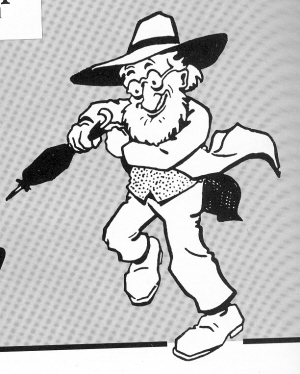Want
exciting variations
to liven up a static juggling routine?
Try
adding some movement to your juggling. Be creative with the movement
and you can tum it into a dance of the jugglers.
To
begin, walk around while you're juggling three clubs (or balls or
rings). Walk slowly in straight lines at first, then try walking
sideways to your left or right. Finally try turning corners without
losing the pattern. You'll find that you have to lead yourself when
you're moving, especially when you're turning. Otherwise your props will
be left behind, on the floor.
Now
try backing up while juggling. Then slow down and go forward. Notice
again that you have to lead yourself to keep the clubs from crashing
into your body or flying away when you change directions. The key is
simply not making the transitions faster than what you can handle. With
practice, you can learn to run all over the place while juggling.
If
you can wander around while juggling, there's no reason not to do it
while passing clubs (or balls, etc.). Start by moving slowly toward your
partner, who should slowly back away. Then reverse directions. Move the
pattern sideways by having one partner move to the right while the other
moves to the left. Again, reverse directions.
Now
both of you can move to the right to make the pattern rotate about its
center. You always have to lead your partner, but in this
counterclockwise turning, if you lead too far, you'll hit your partner's
club, so that probably limits your speed. On the other hand, if you
rotate clockwise (each person moving to the left), the collision problem
disappears and you can throw far ahead of your partner.
A
simple move is to get closer to, or farther away from, your partner. This
is a good practice for times when you might need to make shorter
or longer throws.
If
you combine the above possibilities, you can choreograph a dance with
your partner, sometimes moving slowly
and at other times faster. It's generally easier if you both know
which way you're going to move next, but here's an interesting game,
much like a dance, with one person leading and one following.
One
partner can at any time choose to move in any direction at any speed
desired. The second partner simply responds to the movement with a
compatible movement. For starters, always keep the passing distance and
direction constant, as
you move forwards, backwards or sideways. Later see if the leading
partner can induce the follower to turn or rotate as well.
Now it's really a dance, and with a good leader and a good
follower, it can flow beautifully around the floor.
Or, let both people try to influence each other without any preplanned flight path. See where it leads you. Now that you're adept at gliding while juggling, let's add some more people and different ideas. |
